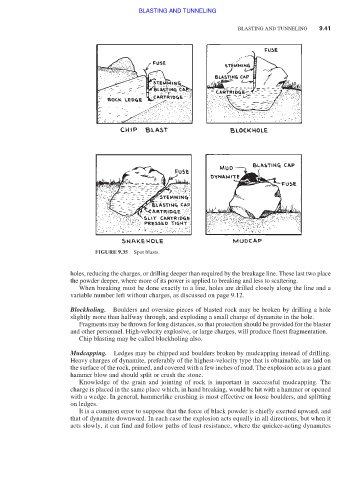Page 441 - Moving the Earth_ The Workbook of Excavation
P. 441
BLASTING AND TUNNELING
BLASTING AND TUNNELING 9.41
FIGURE 9.35 Spot blasts.
holes, reducing the charges, or drilling deeper than required by the breakage line. These last two place
the powder deeper, where more of its power is applied to breaking and less to scattering.
When breaking must be done exactly to a line, holes are drilled closely along the line and a
variable number left without charges, as discussed on page 9.12.
Blockholing. Boulders and oversize pieces of blasted rock may be broken by drilling a hole
slightly more than halfway through, and exploding a small charge of dynamite in the hole.
Fragments may be thrown for long distances, so that protection should be provided for the blaster
and other personnel. High-velocity explosive, or large charges, will produce finest fragmentation.
Chip blasting may be called blockholing also.
Mudcapping. Ledges may be chipped and boulders broken by mudcapping instead of drilling.
Heavy charges of dynamite, preferably of the highest-velocity type that is obtainable, are laid on
the surface of the rock, primed, and covered with a few inches of mud. The explosion acts as a giant
hammer blow and should split or crush the stone.
Knowledge of the grain and jointing of rock is important in successful mudcapping. The
charge is placed in the same place which, in hand breaking, would be hit with a hammer or opened
with a wedge. In general, hammerlike crushing is most effective on loose boulders, and splitting
on ledges.
It is a common error to suppose that the force of black powder is chiefly exerted upward, and
that of dynamite downward. In each case the explosion acts equally in all directions, but when it
acts slowly, it can find and follow paths of least resistance, where the quicker-acting dynamites

